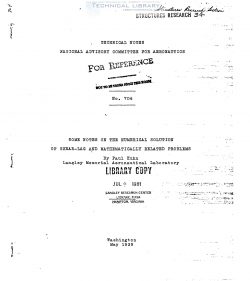naca-tn-704
- Version
- 148 Downloads
- 588.51 KB File Size
- 1 File Count
- November 29, 2016 Create Date
- November 29, 2016 Last Updated
National Advisory Committee for Aeronautics, Technical Notes - Some Notes on the Numerical Solution of Shear Lag and Mathematically Related Problems

The analysis of box beams with shear deformation of
the flanges can be reduced to the solution of a differ—
ential equation. The same equation is met in other prob—
lems of stress analysis. No analytical solutions of this
equation can be given for practical cases, and numerical
methods of evaluation must be used. Available methods
are briefly discussed. Two numerical examples show the
application of the step—by—step method of integration to
shear— lag problems.
When a box beam is subjected'to bending moments, the
stress distribution differs somwehat from that given by
the ordinary theory of bending. The reason for these dif—
ferences, denoted by the term “shear-lag action," lies in
the fact that the cover sheet suffers appreciable shear
deformations. particularly after it buckles into diagonal—
tension fields. Under certain simplifying assumptions
discussed in reference 1. the analysis of this problem
leads to a differential equation of the type
In this equation, x is the distance along the span,
and y may denote, for instance, the bending stress in
the flange, or the shear stress in the cover. The mean-
ing of K1 and K8 depends on the meaning assigned to
be in general a tendency of the cross sections to warp out
of their plane. At the support, this warping is more or
less completely prevented and bending stresses arise (ref-
erence 2). Under certain simplifying assumptions, the
analysis of this problem also leads to an equation of type
The same equation is obtained in a number of other
cases. A quite well—known case is the beam under combined
lateral loading and axial tension (reference 3).
Analytical solutions of equation (1) can be given
when K1 and K3 are constants or simple functions of
x (reference 3). In many practical problems, however.
K1 and K3 vary along the span in a manner that is dif—
ficult to define by simple mathematical functions, a dif-=r
ficulty occurring particularly in box—beam problems. It
is therefore necessary to use numerical methods fer the
solution of given problems.
| File | Action |
|---|---|
| naca-tn-704 Some Notes on the Numerical Solution of Shear Lag and Mathematically Related Problems.pdf | Download |

Comment On This Post